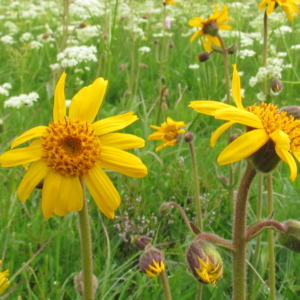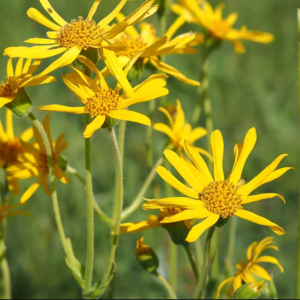


Geographical Origin & Distribution
Arnica plants (there are about 30 different ones) from the family of the Asteraceae are native to mountainous regions of Europe and the USA. The most well-known species in this genus is Arnica Montana. The plant will also grow wild in dry pine forests, open forest edges, grazed moorland, and even roadsides.
Historical Use
Arnica is also known as wolf’s bane, leopard’s bane or mountain Arnica, which may be a little confusing, as there is another plant named wolf’s or leopard’s bane. This is a poisonous plant called Aconitum, which does look very different, though.
Arnica preparations have been used for centuries in traditional medicine. In fact, Arnica is one of the oldest known medicinal plants. The use goes back to the Middle Ages. Hildegard of Bingen, a Benedictine nun who died in 1179, first mentioned the plant and attributed magical powers. Under the name “Arnica”, the plant gets mentioned for the first time in 1583, and by the end of the Middle Ages, the healing properties of the plant are widely known. Native Americans also knew about the plant’s healing properties, and in the 17th century, European pharmacopoeias mentioned Arnica as a remedy for a long list of conditions.
From a certain concentration, some active substances have toxic tendencies – hence, Arnica is only safe to be used externally!
Medical Use
Arnica is recommended for external use as an ointment, gel, or cream.
Common Applications
Bruises & Contusions: Arnica helps reduce swelling, discolouration, and tenderness after impact injuries.
Sprains & Muscle strains: it speeds up the resolution of inflammation and discomfort in tendons, ligaments, and muscles.
Post surgical recovery: Arnica minimises swelling, bruising, and pain after surgical procedures.
Arthritic pain & Joint inflammation: Creams and gels may ease stiffness and pain.
Minor wounds: Arnica supports tissue regeneration and reduces local inflammation. CAUTION: never apply Arnica preparations to open or broken skin.
Purchase Arnica preparations in the UK from our favourite supplier
Active Substances
- Sesquiterpene lactones: helenalin and dihydrohelenalin are responsible for much of Arnica’s anti-inflammatory effect. They can inhibit the activity of NF-kB and other pathways involved in inflammation, but also account for some of Arnica’s potential skin irritation in sensitive individuals.
- Flavonoids: powerful antioxidants with anti-inflammatory properties. These include quercetin and luteolin.
- Phenolic Acids: caffeic acid and chlorogenic acid with antioxidant activity.
- Essential Oils: Arnica contains thymol derivatives which are antiseptic and have antimicrobial properties.
- Coumarins: scopoletin may contribute to anti-inflammatory and anticoagulant effects.
- Polysaccarides: they modulate immune responses and wound healing.
Chemical Breakdown (per 100 g of dried Arnica flower heads)
Sesquiterpene lactones: 0.3%–1.5%
Flavonoids: 0.4%–2.4%
Phenolic Acids: 1.0%–2.4%
Essential Oils: 0.2%–2.2%
Coumarins: traces
Polysaccarides: traces
BITTER
Bitters are herbs and substances known for their bitter taste, which stimulates…
digestion, detoxification, and other physiological processes. They play a foundational role in many traditional healing systems like Ayurveda, Traditional Chinese Medicine (TCM), and Western herbalism as a very complex group of phytochemicals that stimulate the bitter receptors in the mouth.
Taste: their distinct bitter flavor activates receptors in the mouth and digestive system.
Action: stimulating bile production, enhancing digestive enzyme secretion, improve appetite and digestion.
Tonic Effect: bitters are considered tonics for the digestive system, promoting overall balance and function.
Energetics: used to reduce heat, inflammation, or excess dampness in the body.
They were some of the most valuable remedies in ancient medicine. Many of these reputations are being supported by new research on the role of bitter receptors in the mouth and elsewhere round the body. Bitters were also seen as ‘cooling’ reducing the intensity of some fevers and inflammatory diseases.
Planting & Harvesting
Preferred Location
Basic Information
Leaves
There are large oval leaves with rounded tips are basal green that grow level to the ground. In addition, the plant grows small, spear-shaped leaves, aggregated in rosettes.
Flowers
The flowers will appear between June and September and are composed of orange-yellow discs with 10-15 yellow florets and reached sizes of up to 5 cm in diameter.
Seeds
Sow the seeds in autumn on top of the soil, as they need the cold months and light for germination.
Harvest
The flowers are best harvested between July and August. Roots should be at least 2-3 years old.